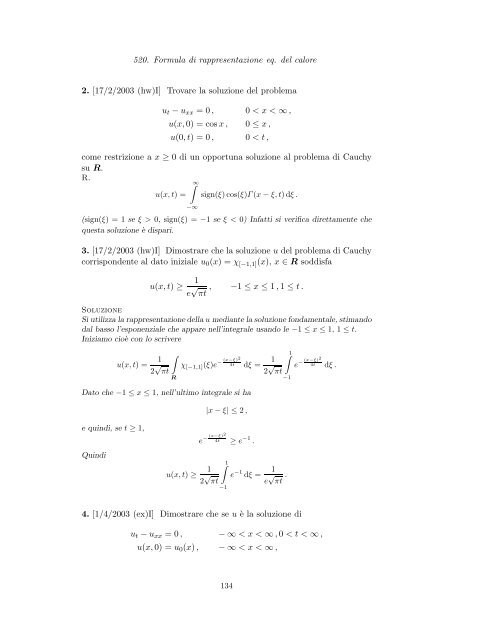Problemi d'esame ed esercizi di Equazioni alle Derivate Parziali
Problemi d'esame ed esercizi di Equazioni alle Derivate Parziali
Problemi d'esame ed esercizi di Equazioni alle Derivate Parziali
You also want an ePaper? Increase the reach of your titles
YUMPU automatically turns print PDFs into web optimized ePapers that Google loves.
520. Formula <strong>di</strong> rappresentazione eq. del calore2. [17/2/2003 (hw)I] Trovare la soluzione del problemau t −u xx = 0, 0 < x < ∞,u(x,0) = cosx, 0 ≤ x,u(0,t) = 0, 0 < t,come restrizione a x ≥ 0 <strong>di</strong> un opportuna soluzione al problema <strong>di</strong> Cauchysu R.R.u(x,t) =∫ ∞−∞sign(ξ)cos(ξ)Γ(x−ξ,t)dξ.(sign(ξ) = 1 se ξ > 0, sign(ξ) = −1 se ξ < 0) Infatti si verifica <strong>di</strong>rettamente chequesta soluzione è <strong>di</strong>spari.3. [17/2/2003 (hw)I] Dimostrare che la soluzione u del problema <strong>di</strong> Cauchycorrispondente al dato iniziale u 0 (x) = χ [−1,1] (x), x ∈ R sod<strong>di</strong>sfau(x,t) ≥ 1e √ , −1 ≤ x ≤ 1,1 ≤ t.πtSoluzioneSi utilizzalarappresentazion<strong>ed</strong>ellaum<strong>ed</strong>iantelasoluzionefondamentale, stimandodal basso l’esponenziale che appare nell’integrale usando le −1 ≤ x ≤ 1, 1 ≤ t.Iniziamo cioè con lo scrivereu(x,t) = 1 ∫2 √ πtRχ [−1,1] (ξ)e − (x−ξ)24t dξ = 12 √ πt∫ 1−1e −(x−ξ)2 4tdξ.Dato che −1 ≤ x ≤ 1, nell’ultimo integrale si ha|x−ξ| ≤ 2,e quin<strong>di</strong>, se t ≥ 1,Quin<strong>di</strong>u(x,t) ≥ 12 √ πte −(x−ξ)2 4t ≥ e −1 .∫ 1−1e −1 dξ = 1e √ πt .4. [1/4/2003 (ex)I] Dimostrare che se u è la soluzione <strong>di</strong>u t −u xx = 0, −∞ < x < ∞,0 < t < ∞,u(x,0) = u 0 (x), −∞ < x < ∞,134
















